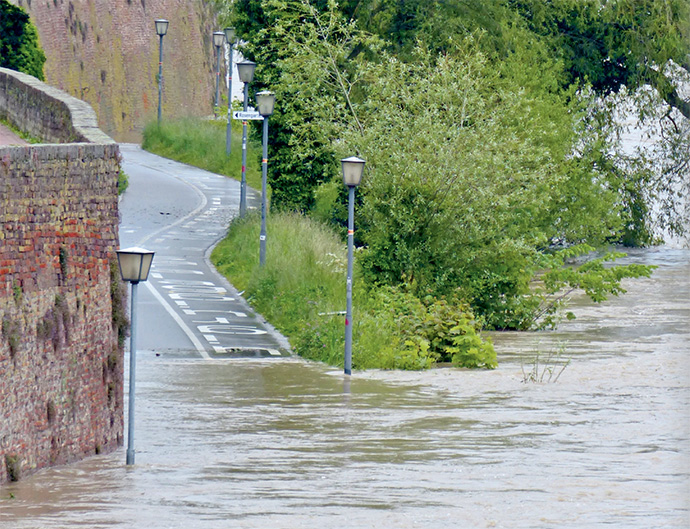Danube Watch 2/2021 - Expect the unexpected: Flood Risk Management in the Danube River Basin and Beyond
Expect the unexpected:
Flood Risk Management in the Danube River Basin and Beyond

Floods are natural phenomena. They shape natural landscapes, create habitats and support ecosystems. However, floods might become catastrophes when they interfere with human activity.
T he severe flood event in central Europe in July 2021 again stressed our tremendous vulnerability against natural hazards. The high, quite frankly beyond belief, numbers of casualties and amount of damage seen particularly in Germany, Belgium, France, the Netherlands and Luxembourg emphasize the imminent need to approach flood risk management in an integrated way. The awareness against residual risk by means of overtopping of existing flood protection schemes and the potential failure of dykes, dams, forecasting and early warning systems as well as past decisions in settlement development should give momentum to implement our integrated strategies and measures to avoid and reduce flood risk.
Adding to that, an uncertain future due to likely impacts of climate change on flood hazards pose an as-yet unsolved challenge in the framework of risk management. The flood events during the last two decades have increasingly highlighted that human behaviour – especially settlement development, infrastructure expansion, site development for industry and trade, sealing of land and the accompanying reduction of retention areas – have significantly increased flood risk. The whole risk cycle needs to be considered appropriately by strengthening the knowledge on hazard and vulnerability.
On basin-wide and administrative level, this process of better understanding risk and the coordination between relevant sectors is supported by the implementation of the EU Floods Directive. Based on a preliminary flood risk assessment and the preparation of flood hazard and risk maps, flood risk management plans are established. This implementation process supports the institutionalisation of integrating sectors beyond flood protection. Decisions within the context of spatial planning, building regulation, emergency management, agriculture, forestry, environment, nature conservation, awareness raising, information and participation can be crucial contributors to reducing flood risk.
Throughout the centuries, the Danube countries have suffered from many disastrous flood events. In response, the Action Programme for Sustainable Flood Prevention in the Danube River Basin was adopted at the ICPDR’s Ministerial Meeting on 13th December 2004, marking a first step towards integrated risk management predating the implementation of the EU Floods Directive.
As a follow-up to this Action Programme, 17 sub-basin flood action plans were published by the ICPDR in 2009. They were based on 45 national planning documents and covered the entire basin. They provided the first ever comprehensive overview of actions to reduce flood risk in the whole Danube River Basin. The ICPDR also committed to implement the EU Floods Directive even though not all countries of the Danube Catchment are obliged to do so, as not all are EU Member States. This again shows the pioneering work that’s already been done on catchment scale.

The 1st Danube Flood Risk Management Plan, according to the Floods Directive adopted in 2015, set the flood risk management priorities for the Danube River Basin until 2021. It represented a milestone in the ICPDR’s work towards sustainable flood risk management addressing all aspects of flood risk management. It focused on prevention, protection and preparedness, including measures for achieving the established objectives and including calls for solidarity among all ICPDR Contracting Parties.
In 2021, the updated Danube Flood Risk Management Plan outlines the key flood risk management priorities for the Danube River Basin until 2027 and is a principal instrument for the coordination of the implementation of the EU Floods Directive. At the same time, this plan demonstrates the efforts made by the ICPDR in coordinating the application of the Floods Directive (FD) and of the Water Framework Directive (WFD), focusing on opportunities for improving efficiency and information exchange, and towards the achievement of common synergies and benefits regarding the environmental objectives of the WFD.
The updated DFRMP presents the strategic basin-wide level measures to prevent and reduce flood-based damage to human health, the environment, cultural heritage, and economic activity. Special attention in the 2021 update is given to measures employing areas which have the potential to retain flood water, such as natural floodplains as well as the other areas enabling controlled flooding. When it comes to prioritisation, measures favoured were those sufficiently robust to the uncertainty in forecasting of climate change impacts. The major ICPDR platform for a joint implementation of the strategic level measures are transboundary projects.
Today, it is of the utmost importance to translate the strategic basin-wide level measures and the measures defined on country level to the regional and local level to raise awareness on all the options we have at hand to reduce flood risk.
We are well advanced in the development of integrated, anticipatory approaches having numerous options and measures to manage flood risk. However, totally unexpected events like the one in July 2021 demonstrate the urgency with which we can find ourselves facing sudden setbacks. Our deepest sympathy is with the victims and citizens affected by this extreme event.






